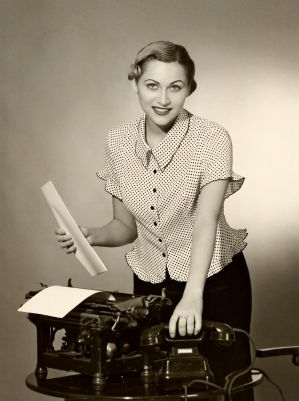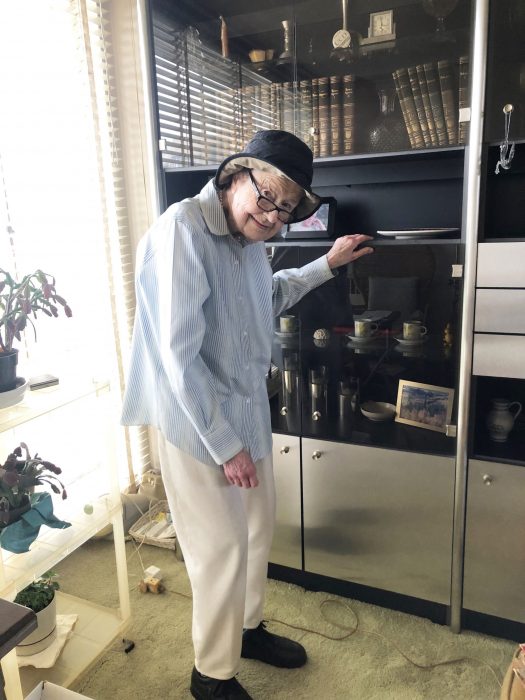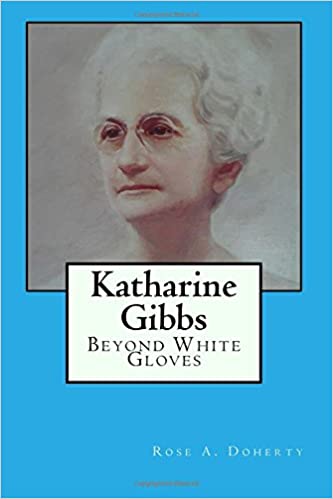BofA offices were set up just like ‘Mad Men,’ recalls Stonestown senior and graduate of the famed Katharine Gibbs ‘white glove’ secretarial school
Kathy Schmidt went to high school in Kansas, where her father taught singing at the college level. Her mother taught high school until she married. Schmidt graduated with a bachelor’s degree in English literature and a minor in Spanish from Wheaton College in Massachusetts. But in the early ’50s, a woman with that kind of education couldn’t do anything but teach, she said. And she didn’t want to be a teacher.
So, she went off to Chicago to the Katharine Gibbs School to become a secretary. We talk with her about what that was like. The Gibbs schools were famous for turning out top-notch secretaries and improving the professionalism of the trade.

The Katharine Gibbs School opened its doors in 1911 with Gibbs as teacher and her sister as manager. Gibbs, a 46-year-old widow looking for a way to support herself and her two young sons, had taken over an upstate New York secretarial school. They broadened the curriculum to include not just stenography but other skills, such as accounting, and how to conduct oneself professionally, according to the New England Historical Society. Students were required to wear hats, heels and white gloves. The goal was to train students for high-paying secretarial positions suitable for college and high school graduates. Enrollment soon grew, especially as men, who had once filled most secretarial positions, went off to fight in World War I. By 1918, there were Gibbs school branches near every Ivy League university. When Gibbs died in 1934, her younger son and his wife took over the schools. They sold it in 1968 and some campuses closed. Today, the Katharine Gibbs School in Melville, N.Y., offers secretarial and other certificate programs as well specialized associate and bachelor’s degrees, including business, web, game and graphic design and criminal justice.
Senior Beat: You went to the Gibbs School in Chicago. Tell us what it was like.
I went up and stayed there for a year. And I thought I would never live through it. But I did. It was one rough education really. They had a beautiful, old Edwardian house up on the north side, near Lake Michigan. And you’d live there. And you got up at seven o’clock every morning for a communal breakfast.

And then you went into one of three classrooms. One for typing, one for accounting, one for shorthand. The first day we were given a 15-minute typing test, which we had to pass with no more than 100 errors. Oh, my God. I had 150 the first time. And you had a test in shorthand, which, of course, most of us had never used. We could graduate with 90 words a minute, but it was better if it was above 110 or 140. Of course, I didn’t get a thing the first day. I thought I’ll never get through this year. But I graduated finally, with 120 words a minute in shorthand.
Senior Beat: Who were the other students?
It was interesting, because we were from everywhere. There were local gals and ones from Wisconsin and Minnesota, Ohio. And there was me from Kansas. And then another girl moved all the way from Colorado from Denver. And she didn’t want to be a secretary; she wanted to be an artist … and ended up doing that.
What else can I say … it was tough and we hated it all the time. I’m sure we’ve all been very grateful to it since we came out. If you came out of Katy Gibbs, employers knew they were going to get somebody who was up to it. Accounting was good for us. I can still catch the CPA who does my taxes every once in a while.
Senior Beat: How were the teachers?
The typing teacher was what you think of as the stern disciplinary type. I always expected her to come with a ruler. She dressed like the characters you see in the movies of the prim schoolmarm. She had a wacky sense of humor, which was her saving grace. But she might come up while you’re typing away and then you got terribly nervous and made mistakes. But that was good for us probably. After being exposed to her for a year, we could tackle a tough boss. The accounting lady was more laid back. The shorthand teacher was very businesslike – you had to be absolutely perfect.
Senior Beat: Besides the basic work skills, what else did they teach you?
Because you went to different places as a temp worker, you had to learn different vocabularies – like banking had its own. But the specific lingo, you sort of learned on the job.
When I began working, in 1953, women in the workforce wore nice shoes – they didn’t have to be high heels – and a suit or jacket and skirt, or a skirt and a nice blouse. Nothing fancy. Or when the weather got cold, usually a sweater set. You know, like, the black cardigan and the V-neck or shell or whatever. That was an ensemble.

You couldn’t walk in in jeans. You had to have at least one suit probably and then different skirts. And you learned long before they started talking about it in the fashion magazines have things that would blend together so they could be used often. We were required to wear gloves when we went out on interviews or were representing the school in some way. I don’t remember the hats though.
Senior Beat: Tell us about your first jobs.
First, I worked in the alumni office at the University of Kansas. And then I went to Philadelphia to work for the old Curtis publishing company, which put out the “Saturday Evening Post,” and also one for all farmers and ranchers called “Country Gentleman.” I was secretary in a group of three. We were there to type up what anyone needed, take it to the printing department, do letters for the various writers on the magazine.
Our tools were pens, stenographic pads and manual typewriters. A telephone. No copy machines. If you used carbon paper, you had your erasers to take care of mistakes. White Out didn’t turn up until it 1956. Every office had an adding machine.
I got to see the whole Philadelphia area very carefully, because their editorial offices were right down on Independence Square. So, it was fun. I walked from my apartment down to Independence Square, passing through some of the more ancient parts of Philadelphia. I would walk up and down the different streets that are now the heart of the historic district.
It was a more genteel working world then. It was ladies or gentlemen, and not confined to the upper crust. You could be a coal heaver and still be a gentleman depending on the way you looked at the world and looked at people. here was definitely the black section of Philadelphia, the lower-income class white section, but there wasn’t the obvious resentment between different classes, so that I never had any fear of wandering into these areas. Things did change around a good bit. The ’60s came along and everybody got emancipated … and all the problems and resentment started to rise. They bubbled up, I guess, which is probably a very good thing for people.
Senior Beat: How did you end up in San Francisco?
Marge, one of the people I met at the Katy Gibbs, went to work in Kalamazoo, Mich., for one of the old pharmaceutical companies. But she was finally getting bored with it and wanted to get away. So, I wrote her and said, I’m thinking of going either to Colorado or to California to look for work. Would you like to come? And she wrote back, ‘Oh, yeah.” So, in the summer of ’54, we met in Lawrence, Kansas, and set off in the new car I had gotten for my birthday. It was a 1954 Chevrolet Bel Air, two door sedan, cream and this beautiful, sort of a Nile green combination, and white upholstery.
When we came to San Francisco, we stayed in an establishment for single females. We couldn’t stand it. It was so regimented. So, we went around looking for a place to live. At that time, there were a lot of apartments and houses and we answered a lot of ads. One of the first we looked at was on Macondray Lane, but a new tenant had already moved in. But he said his neighbor knew a woman looking to rent out the apartment she’d created in the coachman’s rooms atop the old carriage house behind her home on Telegraph Hill. She kept her car in the garage on the ground floor.
The contact was Terry O’Flaherty, at that time the television writer for The Chronicle. You know, television was coming in, and it was a big thing. So, he had a big splash every day on the entertainment section. And he was funny.
The carriage house was on this little lane that ended at a big gate and fence. It was hard to drive. It was isolated in a way but it was very, very pleasant. And, of course, we were at the top of the hill just before it starts sloping up toward Coit Tower. We could look out on this gorgeous garden that the neighbors had and across to the Bay Bridge.
There was a nice big kitchen in the back that looked down on her garden. And beautifully equipped with everything: cutlery dishes, pots, pans. Then off that was a little vestibule with stairs going down into her garden. Marge and I stored all sorts of things there that there had to be kept cool. There was a nice big living room, with a day couch that I slept in. The dining room window looked out on the Bay Bridge. The bedroom had a double bed, and we shared a closet. It was grand for five years. Then I went off with my parents to Europe for a year.
Senior Beat: What did you do when you came back?
When I came back, we ended up in one place I said we would never live: Stonestown. It was so new and modern, and it was behind the mall and overlooking Highway One. We had a garden apartment right over the highway. It was noisy, as all the families were in the garden apartments. But it was affordable and near transportation for our jobs.
We later moved into one of the high-rise buildings with three bedrooms because my parents usually spent Christmas with us. And we only had a one bedroom in the garden apartments. By that time, we were both making enough money; we could afford it. I was working for the Academic Senate at UCSF. (Schmidt still lives in the high-rise; Marge passed away in April 2017.)
Senior Beat: Where have you worked in San Francisco?
One of my first temp jobs in San Francisco was at the Bank of America at California and Kearny. BofA was the biggest thing in San Francisco business then. On my interview, I arrived on the 9th floor by elevator, to be met by this little fellow in what looked like a drum major outfit who was responsible for directing you to the right office.
But first he had to check with the ice-queen receptionist. When she gave him the nod, he walked me down the length of the California street side of the building, which had about 25 big desks all in a straight row and 25 smaller desks each with its typewriter for the secretaries. They all looked very important, at least in their own eyes. But not to the bosses on their raised platform at the end of the row, just like “Mad Men” but in a bank.
My last job was with the Academic Senate at the University of California-San Francisco, and I was there until I retired.
Senior Beat: What’s the same and what’s different between being a secretary then and now?
Well, I couldn’t tell you because I retired in the mid-1990s. A lot of changes in 20 years! But one thing is that you can show up for work in jeans and a T-shirt in many places now. And workers can agitate more now for what they need or want. We never agitated; we just muttered and grumbled.
How has digital changed things?
Well, everything’s faster, of course, and all office tools are rolled into one —the almighty computer. But when I retired from UCSF, the gal who took my place was used to Apple and she ordered us all Macs. And I loved that little thing. Actually, it wasn’t that little, come to think of it.
Do you think you’d like secretarial work in this new era?
There’s no such job anymore! Everyone is an analyst or an executive or chief administrator of something, no humble secretaries.





